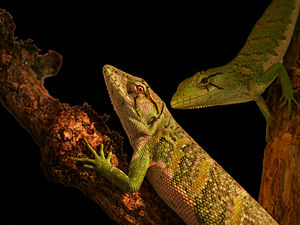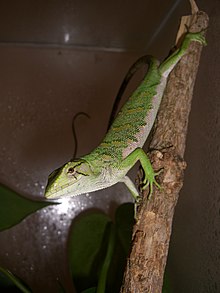Colored iguana
| Colored iguana | ||||||||||||
|---|---|---|---|---|---|---|---|---|---|---|---|---|

Northern iguana ( Polychrus marmoratus ), |
||||||||||||
| Systematics | ||||||||||||
|
||||||||||||
| Scientific name | ||||||||||||
| Polychrus marmoratus | ||||||||||||
| ( Linnaeus , 1758) |
The spotted iguana ( Polychrus marmoratus ), also known as the false chameleon , is a lizard belonging to the six species of spotted iguanas ( Polychrus ). It lives in the treetops of South American rainforests.
features
The colored iguana reaches a total length of 25 to 30 centimeters; the tail takes up two thirds of this. He has a rather slim build, with the males appearing a bit stronger. The head is relatively pointed and is somewhat reminiscent of anole species. The trunk is flattened on the sides, the limbs are relatively thin. The coloring of these lizards is individually variable and depends on mood and activity. The hull color changes between dark and light green; the color of the abdomen is lighter. As a drawing, there are darker, jagged, somewhat oblique cross bars on the trunk. The tail has a marbled speckle.
Occurrence, way of life
The colored iguana occurs in lowland rainforests in South America , for example in Peru , Ecuador , Colombia , southern Venezuela , Trinidad and Tobago , Guyana , Suriname , French Guiana , northern Brazil and possibly also in Bolivia . He stays mainly in the canopy of the trees, where he usually remains motionless.
With their opposing prehensile toes, the species has adapted to life in thin branches and is reminiscent of the old-world chameleons in other features, such as the color and the careful, slow movements . They are diurnal, but still extremely shy escape animals, which are pursued by many predators (birds of prey, cats, etc.). When escaping, they stand on their hind legs and support themselves with their long tails before jumping to the next branch. Colored iguanas actively hunt down smaller invertebrates (insects etc.).
Reproduction, individual development
After a gestation of a few weeks, up to 10 soft-shelled eggs are buried, from which the young hatch after 60 to 70 days. These reach sexual maturity about seven months later. The average age is around five years.
literature
- Günther Nietzke: The terrarium animals. Construction, technical equipment and planting of the terrariums, keeping, feeding and care of the terrarium animals. Volume 2: Plants in the terrarium, breeding and rearing, staying outdoors and wintering, crocodiles, lizards, snakes. 3rd, revised and improved edition. Ulmer, Stuttgart 1980, ISBN 3-8001-7062-0 .
- Uwe Schlueter: Colored iguanas. Way of life, taxonomy and reproduction. Kirschner & Seufer, Rheinstetten 2013, ISBN 978-3-9808264-7-1 .
Web links
- Polychrus marmoratus in The Reptile Database
- Reptilienmanager.de (information on keeping in the terrarium)

